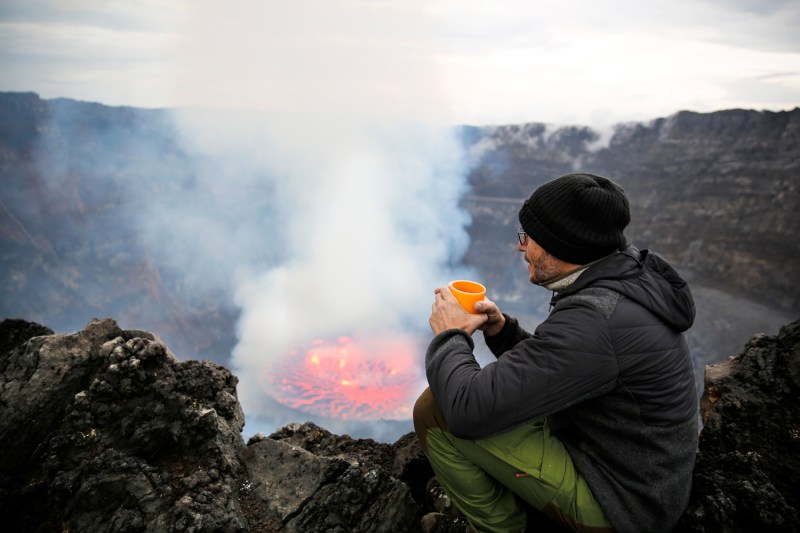
For decades (if not centuries), visitors to Africa were confronted with a Hobson’s choice: partake in a system that compromised local economies and natural environments, or … well, don’t travel to Africa.
Today, the effort to build a more sustainable African tourism model remains a tug-of-war involving political strife and short-term capitalistic interests. Last year, one of the continent’s most prominent wildlife preserves, Virunga National Park, was closed due to a spate of violence that impacted both human life and the lives of the region’s endangered mountain gorilla population.
This year, however, Virunga’s scheduled reopening has rejuvenated worldwide interest in visiting this incomparably rich region.

Located in the Democratic Republic of Congo, Virunga is the oldest and most biologically diverse protected wildlife preserve in Africa. Created to protect many of Africa’s most unique species, the park spans almost 200 miles along the Albertine Rift, the geological split between Africa’s north and south, and is surrounded by the snowcapped peaks of the Rwenzori Mountains. Within the park, West African rainforests meet East African savannah, resulting in an ecosystem of unparalleled diversity. Volcanic mountains, crater lakes, woodlands, wetlands, and open grasslands — just about everything that makes Africa beautiful can be found in Virunga National Park.
Given the opportunity it presents for observing the habits and interaction of so many species, scientists flock to the park in droves for research opportunities. For tourists, however, the park’s principal attraction is the endangered mountain gorilla. Unlike more highly trafficked gorilla habitats, Virunga’s remote location has preserved its “hidden gem” status. While accessing the park requires a multi-stage journey (including a one- to two-hour drive over a dirt road), the effort is rewarded by your arrival in a lush paradise where birds sing in trees that grow tall in mineral-rich soil and a temperate climate is washed with warm breezes by day and cool mists at nightfall.

The park offers a wide range of accommodations, from the Bukima Tented Camp (luxury safari tents set within the gorilla habitat) to the Mikeno Lodge (a sprawling bungalow complex built from lava stone, mahogany and thatch roofs) to the Mount Nyiragongo Summit Shelters (spartan huts perched on the crater rim of an active volcano).
Further Reading
- What It’s Like to Go On a Once-in-a-Lifetime African Safari
- World’s Most Dangerous Volcanoes You Can (But Maybe Shouldn’t) Climb
Virunga National Park also provides a wide variety of options for exploring its wonders; in addition to game-viewing drives through the grasslands, there are mountain hikes, forest walks, and boat cruises on the lakes and rivers that surround the park. While mountain gorillas are the prized viewing opportunity, they are far from the only wildlife attraction in Virunga National Park. As of 2012, at least 218 different mammal species were found within the park’s confines, with even more birds, reptiles, and amphibians within view. Elephants, lions, hippopotamus, crocodiles, and aardvarks are just a few of the species that can be seen there. And along with gorillas, the primate roster includes baboons, colobus, and several species of monkey. Visitors can even join a team of zoological volunteers for a chimpanzee habituation session, which helps acclimate them to the presence of humans so that their habits can be studied for the purpose of conservation. It’s a one-of-a-kind experience that lets you interact (at a distance) with these remarkable animals, observing their daily life at close range.

For a departure from the wildlife viewing experience, intrepid visitors can opt for a hike up the side of Mount Nyiragongo, an active volcano featuring a lava lake bubbling under the pressure of year-round eruptions. Hiking to the summit of Nyiragongo offers a rare opportunity to observe boiling lava as it gushes from the earth’s crust. There are also opportunities to be a guest of the Twa, an indigenous community of hunter-gatherers who have lived in the region for centuries and now invite visitors to experience their traditional way of life. Guests of the village can listen to stories, make art, participate in music and games, or take walks through the forest with a local guide.
Most importantly, a new effort called the Virunga Alliance will work to ensure that the park’s wealth of resources benefit more than just the tourist population. By improving local infrastructure, social services, and economic opportunities, the Virunga Alliance aims to provide long-term sustainable economic growth that will protect against violence by empowering the surrounding community.


